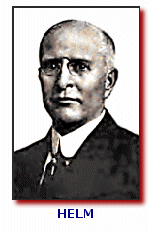 then about the holding of meetings of private
groups—even partisan political ones—in courtrooms.
then about the holding of meetings of private
groups—even partisan political ones—in courtrooms.
Thursday, January 31, 2008
Page 15
REMINISCING (Column)
Helm Leads Local Bar During Crackdown on Shysters
By ROGER M. GRACE
Bankruptcy Referee Lynn Helm was elected a trustee of the Los Angeles Bar Assn. on Feb. 3, 1906, the eve of “John Marshall Day.” Three years later, he would be chosen on “John Marshall Day” to head the group.
It just might be that you haven’t heard of “John Marshall Day.” It was first celebrated Feb. 4, 1901, as encouraged by a proclamation of the American Bar Assn. in 1899. The purpose was to commemorate the centenary of Marshall’s swearing-in as chief justice of the United States. Celebrations were held throughout the nation. The one in Los Angeles—where courts were closed for the day in tribute to Marshall—proved beneficial to the growth of the Los Angeles Bar Assn.
A dinner was staged by the association that night in its quarters in the Wilcox Building (where Helm had his office and from whence the newspaper you’re now reading emanates). The Los Angeles Times’ issue the next morning says:
“In anticipation of the banquet, attendance of which is limited to members of the Bar Association, there has been a very considerable attention to the membership of that hitherto rather quiet body; almost, if not quite, 100 members of the bar having recently joined the association; thus more than doubling its members.”
The local bar association continued holding its annual business meeting on or within a few days of John Marshall Day for a number of years.
Helm’s
election as president on
John Marshall Day in 1909 came at a noon meeting. It was held, as the one three
years before had been, in Department Six of the Los Angeles Superior Court.
There was nothing unusual then about the holding of meetings of private
groups—even partisan political ones—in courtrooms.
then about the holding of meetings of private
groups—even partisan political ones—in courtrooms.
Each of those on the Nominating Committee’s slate was quickly confirmed as officers, by unanimous vote of the 149 members present. There was then a total membership of about 400.
Attendees adjourned to Levy’s, a local eatery…one previously mentioned here that sold loaves of bread stuffed with oysters (and whose proprietor, Al Levy, from Dublin, is credited with inventing the oyster cocktail). There was an incentive for the 149 members to show up for the voting: the association picked up the tab for lunch.
Helm’s administration as president was marked by an upsurge in disbarment prosecutions. It would not be for another 18 years that a unified statewide bar association would come into existence, charged by the state constitution with the duty of disciplining errant members. In the meantime, the job was entrusted to local bar groups.
Although legal actions by individuals to bring about a lawyer’s disbarment were theoretically possible, the standard approach of a fleeced client was to report the misdeeds to the local bar association. One such person was Regina Urbach who told the Grievance Committee that her lawyer, J.C. Calhain, pocketed the $55.20 he recovered in a legal action against her creditor. She also alleged that he brought a divorce proceeding in which he purported to represent her, while her husband was the actual client.
On Oct. 7, 1909, an accusation against Calhain was filed in the California Supreme Court, signed by Helm as bar association president and T.W. Robinson as its secretary. The high court referred it to the trial court, and a disbarment proceeding was tried the next month before Los Angeles Superior Court Judge Curtis D. Wilbur (who later became chief justice of California, then secretary of the Navy, and finally a judge of the U.S. Court of Appeals for the Ninth Circuit). Deputy District Attorney John North and attorney Nathan Newby conducted the prosecution.
Calhain was disbarred. Others targeted by the bar association were, also.
A Jan. 7, 1910 article in the Times credits the 1909-10 Grievance Committee (appointed by Helm) with “the most vigorous cleaning up in the history of this county,” adding:
“During its year of service, it has filled with terror the few questionable lawyers who infest the courts of this county.”
The election of new officers was initially slated for John Marshall Day—that is, Feb. 4—in 1910. That was a Friday. But the election wound up taking place the next Monday. Walter Trask was chosen to succeed Helm as president. Trask was a partner in a firm then known as Bicknell, Gibson, Trask, Dunn & Crutcher.
Returning now to 2008…next Monday is Feb. 4. To the best of my knowledge, Department 6 of the Los Angeles Superior Court at its main location, at First and Hill Streets, now presided over by Commissioner Steff R. Padilla, will not be the site of a LACBA meeting or a “John Marshall Day” celebration.
Copyright 2008, Metropolitan News Company